Thunderstone Quest is the best yet!
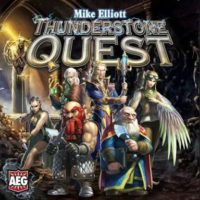
Recruit your heroes, arm your party, and dive into the dungeon to battle monsters!
While that’s the short description of Thunderstone Quest, it doesn’t do it justice at all. That’s because there are a ton of games stating the exact same thing. It’s how it all plays out that makes Thunderstone Quest unique and engaging.
Perhaps a better way to introduce Thunderstone Quest is to simply tell you that the game hits another home run with our boys!
When we played our first games of the original Thunderstone deck-building card game in 2010, it was an immediate hit with our boys. They could add new heroes to their deck, upgrade them with better powers, arm them with cool weapons and spells, then journey into the dungeon taking out a wide variety of beasts. It offered so many fun choices and smooth flow, they were enamored.
That’s why Jaden gave it an emphatic 5 out of 5 in his video review!
Then the expansions started hitting and even our youngest son (only 8 years old at the time) also declared Thunderstone his favorite game.
When AEG released a revised version of the game called Thunderstone Advance in 2012, we likewise acquired a number of Thunderstone Advance expansions over the following years.
Suffice it to say, our boys know Thunderstone well.
However, when AEG announced they were again revising Thunderstone and were set to publish Thunderstone Quest, we rolled our eyes. With all the original and advance cards and expansions already on our game shelves, did we really want to dive into yet another implementation of the game?
Well, a couple months ago we got a copy and gave it a go…
Let’s just say those initial skeptical thoughts were completely washed away!
We all agree — Thunderstone Quest is hands down the best way to play Thunderstone!
(It also happens to be one of the most massive game boxes we own.)
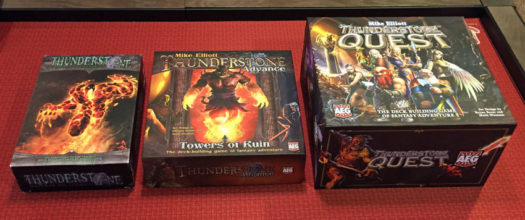
How to play Thunderstone Quest
The general flow of Thunderstone Quest is just like the original Thunderstone. (If you’re unfamiliar with Thunderstone, you can watch our original video review of the game here.)
Players start with a deck of 12 cards consisting of 6 Adventurers, 2 Lanterns, 2 Daggers, and 2 Thunderstone Shards. Each turn players draw cards to their hand and use them in either the Village or the Dungeon. If a player chooses to go to the Village, they use their hand of cards to buy other cards (heroes, weapons, items, spells) to add to their deck. If a player chooses to go to the Dungeon, they use their hand of cards to fight a monster.
As players get more powerful decks, they’ll be able to defeat tougher monsters for more victory points. The player with the most points at the end of the game wins.
But Thunderstone Quest is much more than that!
The original game was only cards. In Thunderstone Quest there’s a big central board, player boards, dungeon rooms, wooden tokens, and hero miniatures!
So let’s dive into some of the main differences…
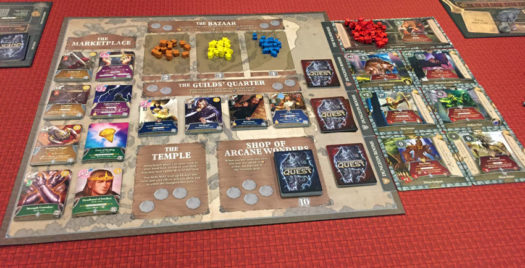
PLAYER BOARDS AND MINIATURES
The addition of player boards is pretty nice since they not only provide space for a player’s deck, discard pile, and tokens. But they also give a reminder of things to do on a turn. In addition, there’s a Hit Points track that we’ll describe shortly.
To the side of player boards is where players can place their Side Quests and Guild Sponsorships (that we’ll also describe shortly).
At first we thought the idea of miniatures for a card game was a crazy idea. But we’ve actually come to like it.
At the start of their turn, players place their miniature on the location where they want to perform actions that turn. This is helpful for getting special actions in the Village as well as knowing what part of the Dungeon you’re fighting in.
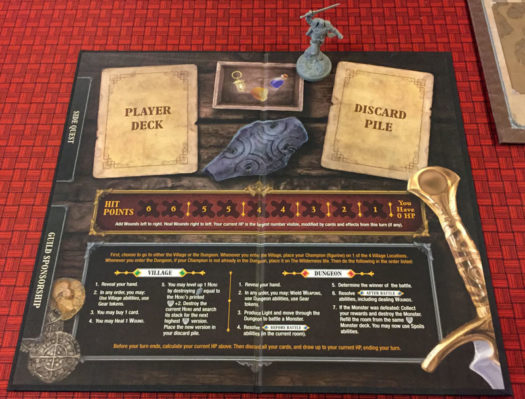
CENTRAL BOARD
Thunderstone Advance came with a central board that provided spaces for cards in the Village as well as Dungeon cards. But in Thunderstone Quest, the board is divided into different sections of the Village that have different actions. When going to the Village, a player places their miniature on a space of the section they want to visit for extra actions.
Any turn they’re at the Village a player will reveal their hand of cards and use Village abilities and Gear tokens. Then a player may buy 1 card (from either the Marketplace or Guild’s Quarters), heal 1 wound and level up 1 Hero.
If they’ve gone to the Guilds’ Quarter, a player may level up 2 different heroes instead of just 1.
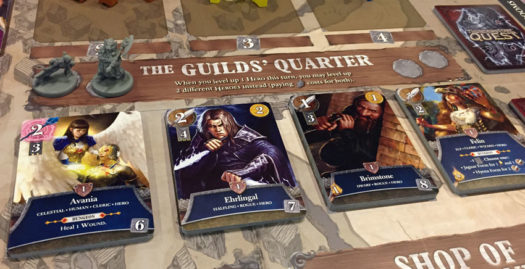
In the Bazaar players can buy more Gear tokens.
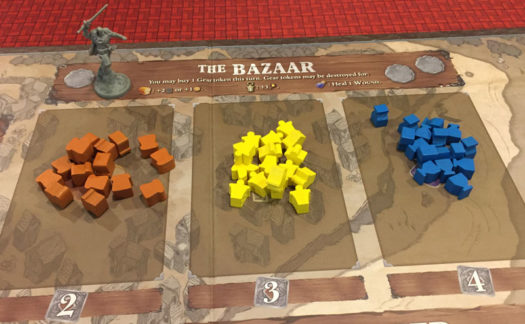
If they’ve gone to the Temple, the player places one or more of the cards from their hand back on their deck (to be used in their next turn) and can heal 1 extra wound. While there, they also get to take a normal Village turn but can’t level up Heroes or use card effects to enter the Dungeon this turn.
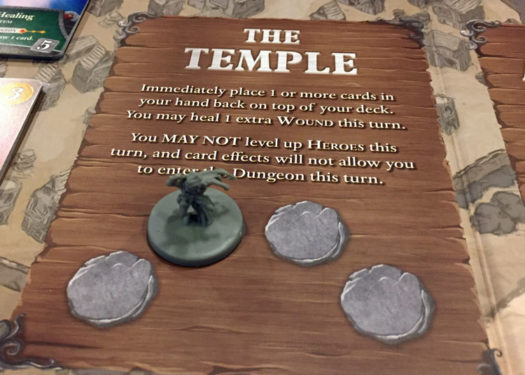
In the Shop of Arcane Wonders players can also spend 10 gold to buy the top card of the Treasure deck.
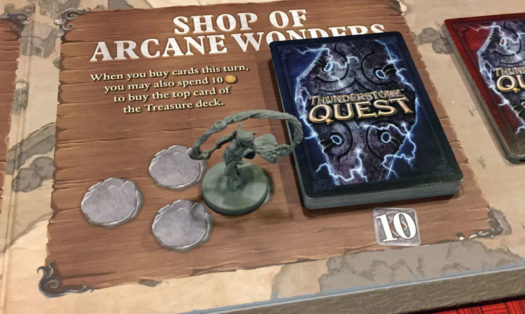
TOKENS
Players will gain tokens throughout a game of Thunderstone Quest. Iron Rations, Lanterns, and Potions can be purchased in the Bazaar or earned as spoils from defeating monsters in the Dungeon.
The benefit of the tokens is that they aren’t discarded each turn like cards are. Instead, they can be used when needed to boost a player’s capabilities. For example, if a player doesn’t have enough light to move into a Dungeon room, they can use (discard) their acquired lantern tokens to have extra light. Iron Rations are used to give a Hero +2 Skill and Potions are used to heal wounds.
Which brings us to the Wounds tokens.
When a player takes wounds during the game, rather than adding a card to their deck, the take a Wound token and place it on the left-most open spot on their player board Hit Point track. When drawing cards at the end of their turn to get ready for their next turn, players only draw the number of cards indicated on their Hit Point track.
So as players take more wounds, they’ll draw less cards into their hand. When players visit the Village, they’ll be able to discard a Wound token (or 2 wounds if visiting the Temple).
The great thing about having Wound tokens rather than gaining cards that clog up your deck is they can be dealt with immediately rather than having them affect you multiple turns later.
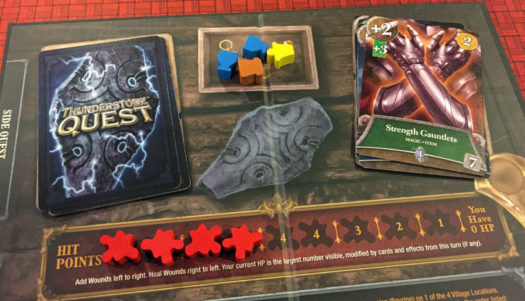
The final tokens in the game are XP tokens. These are gained as players defeat monsters. Rather than adding the monster card to their deck like in the original Thunderstone, players discard the monster card and take the number of XP tokens indicated on the bottom of the monster card. The XP tokens are spent when upgrading heroes on future turns.
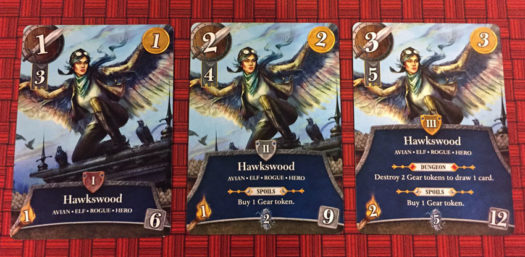
DUNGEON ROOMS AND MONSTERS
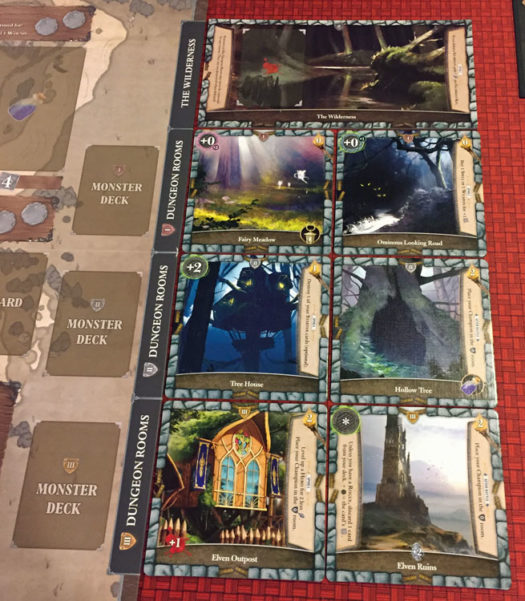
Thunderstone Quest introduces a new approach to Dungeons that we absolutely love!
In the original Thunderstone, there were 3 monsters available to fight at any time. They represented 3 levels of the Dungeon and players would need the right amount of light to delve to the level they wanted.
Well, now there are 7 Dungeon spaces that change every game!
That’s because the Dungeon is comprised of actual Dungeon Room tiles. And each Dungeon Room tile has unique effects!
Some rooms give the monsters in them a boost to its health, armor, or magic. Some rooms have penalties as you enter or try to move through. And some rooms deal out extra wounds. In addition, the Dungeon Rooms may grant special benefits and rewards when fighting and defeating monsters in those rooms – such as extra XP, Treasure cards, or Gear.
At the top of the Dungeon is a Wilderness tile where a monster card will be placed that can be fought any time at that level. Each level of the Dungeon below that will have 2 rooms. To enter a Dungeon Room, the player must have the amount of Light required by that room.
Players can also move through rooms, but will need the combined amount of Light to do so. Even when moving sideways between Dungeon Rooms players need to be aware of the Light required.
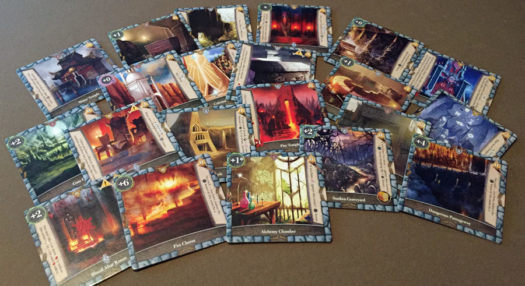
The other big change to the Dungeon is how monsters appear.
Instead of just creating one monster deck, each level in the Dungeon has its own deck of monsters. Like the Dungeon Room tiles, monster cards are labeled as Level 1, Level 2, or Level 3 monsters. They’re shuffled and placed next to that level of the Dungeon. When a monster is defeated, a new monster from that level will be drawn.
If a monster isn’t defeated in battle, neither the hero or the monster leave the Dungeon.
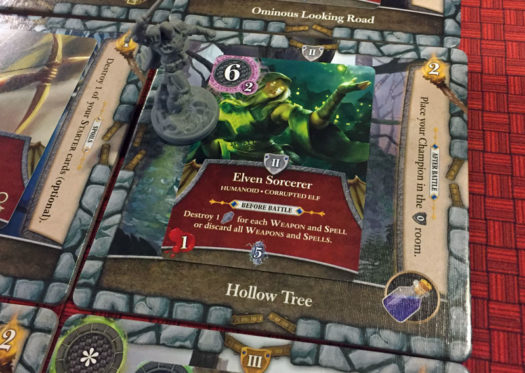
GAME END
When setting up the game, 6 Guardian Keys are shuffled into the monster decks (1 in Level 1, 2 in Level 2, and 3 in Level 3). The final stage of the game triggers at the end of the turn in which the 4th Guardian Key is found.
The monster in the Wilderness is then flipped over to reveal the Thunderstone Guardian monster.
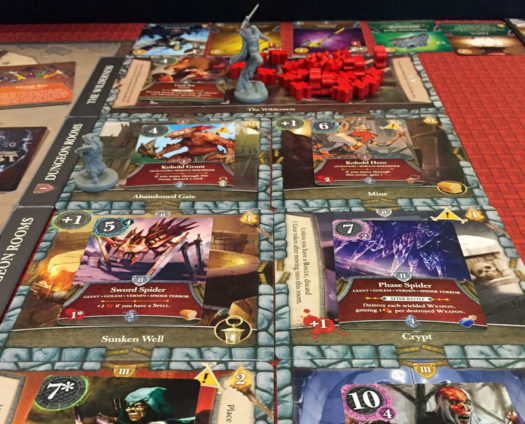
As indicated on the Guardian Key, all players now draw 6 additional cards to their hand and then discard 4. Each player will have one more turn in which they can either take a normal turn or battle the Thunderstone Guardian. If a player battles and defeats the Guardian, the Guardian isn’t removed from the Wilderness. It will still be there for the remaining players to battle as well.
When defeated, a Guardian’s XP is equal to half of the total Attack value, rounded up.
Players then total up all their XP from XP tokens, cards in their deck with XP symbols and Side Quests. The player with the most XP wins!
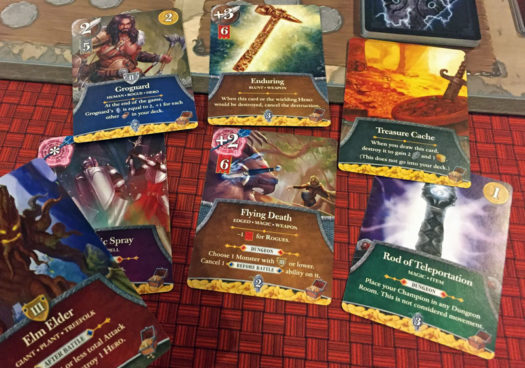
QUESTS, QUEST DECKS, AND SIDE QUESTS
So with all those new aspects of the game covered, let’s take a look at the whole “Quest” part of Thunderstone.
Thunderstone Quest includes a 43-page Questbook that includes 14 suggested setups, called Adventures, and stories to go with them. Each Adventure outlines the sets of card combinations to use for that game experience. What makes it work is that Thunderstone Quest comes with a ton of expansion card decks already in the game.
After the original Thunderstone, we added to it through game expansions. Well, Thunderstone Quest starts out with a bunch of expansions already. Each set is wrapped and the Questbook outlines when to open the new set of cards for the next experience.
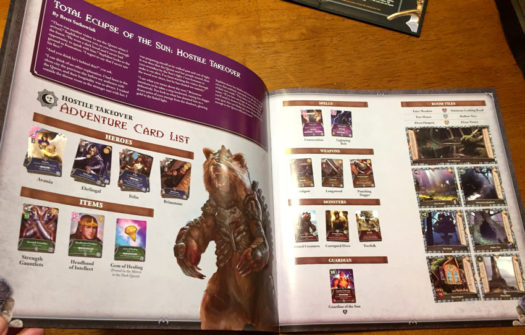
Even though we’ve only played through half of them as outlined in the Questbook, we’re also excited to randomize all the cards to create our own adventures.
In addition, there are Side Quest cards that players can toss into the mix of each of their games.
At the start of the game, players each get 3 random Side Quest cards and select one to keep for the game. They provide secret secondary objectives for players to accomplish along the way. Some side quests reward players with special Legendary cards or victory points.
If that weren’t enough, players can also include Guild Sponsorships in their games. Guild Sponsorships favor one of the classes of heroes and the special abilities can synergize with the chosen side quest.
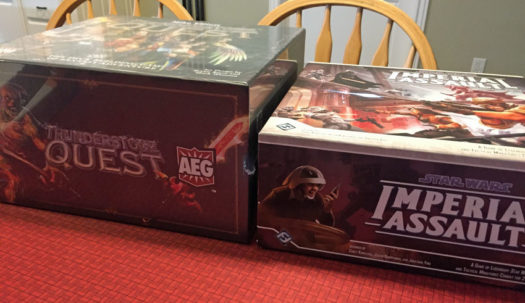
What if you already own Thunderstone or Thunderstone Advance?
For those who already have a copy of Thunderstone or Thunderstone Advance, the big question is, “should I buy a copy of Thunderstone Quest”.
Let’s jump right to the punchline — Thunderstone Quest has a high price tag. That’s because it comes packed with a number of expansion adventures already included.
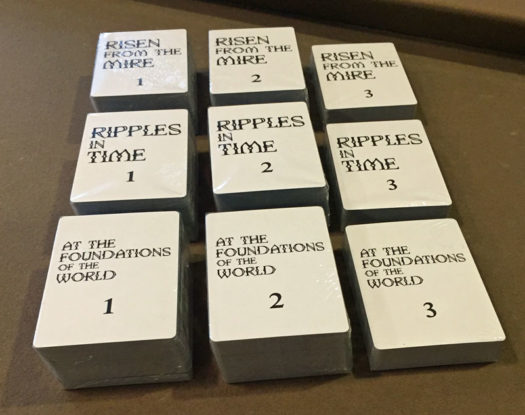
Most likely if you’re considering this question, you own much more than the Thunderstone base games. Have you kept track of how much you’ve spent on the base game plus the expansions?
When you consider that, it’s easier to see that the price of Thunderstone Quest is in line with those all added together.
The benefit to prior versions is that spending the money on expansions was spread out over time. Now it’s a lump sum.
But you could still work it out little by little like you’ve done before. Set aside $35 per month like you were buying expansions and in a few months you’ll be ready to buy Thunderstone Quest.
So the real question is, which version of Thunderstone do you want?
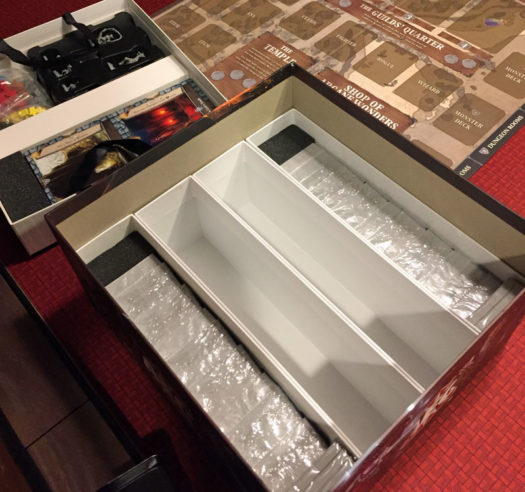
Speaking from experience with all 3 versions of the game and their expansions, our clear vote is on Thunderstone Quest.
At first we considered mixing in prior card sets we love to Thunderstone Quest, but now that we’ve had a taste of it, there’s no need to hang on to what has come before. We’re putting both Thunderstone and Thunderstone Advance and all our expansions for them on our “good-bye” shelf. That means they’ll be up for sale or will go in the next game trade we participate in.
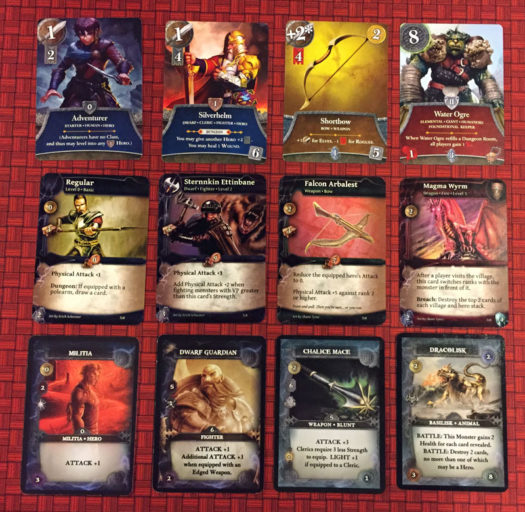
How does Thunderstone Quest score on our “Let’s Play Again” game meter?
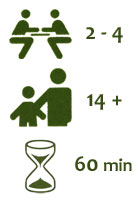 If you haven’t already guessed, Thunderstone Quest scores super high on the boys “let’s play again” game meter.
If you haven’t already guessed, Thunderstone Quest scores super high on the boys “let’s play again” game meter.
Mom and Brooke still don’t have any interest in playing (though Caleb keeps inviting). But the boys in the family love the quest!
And Thunderstone Quest has been a big hit at our monthly Guys Game Night as well.
While we still haven’t played through every quest in the Quest Guidebook yet, not opened all the card packs in this massive game we already know we’re going to play it with regularity.
And we can hardly wait to open all the card packs with future randomized adventures!

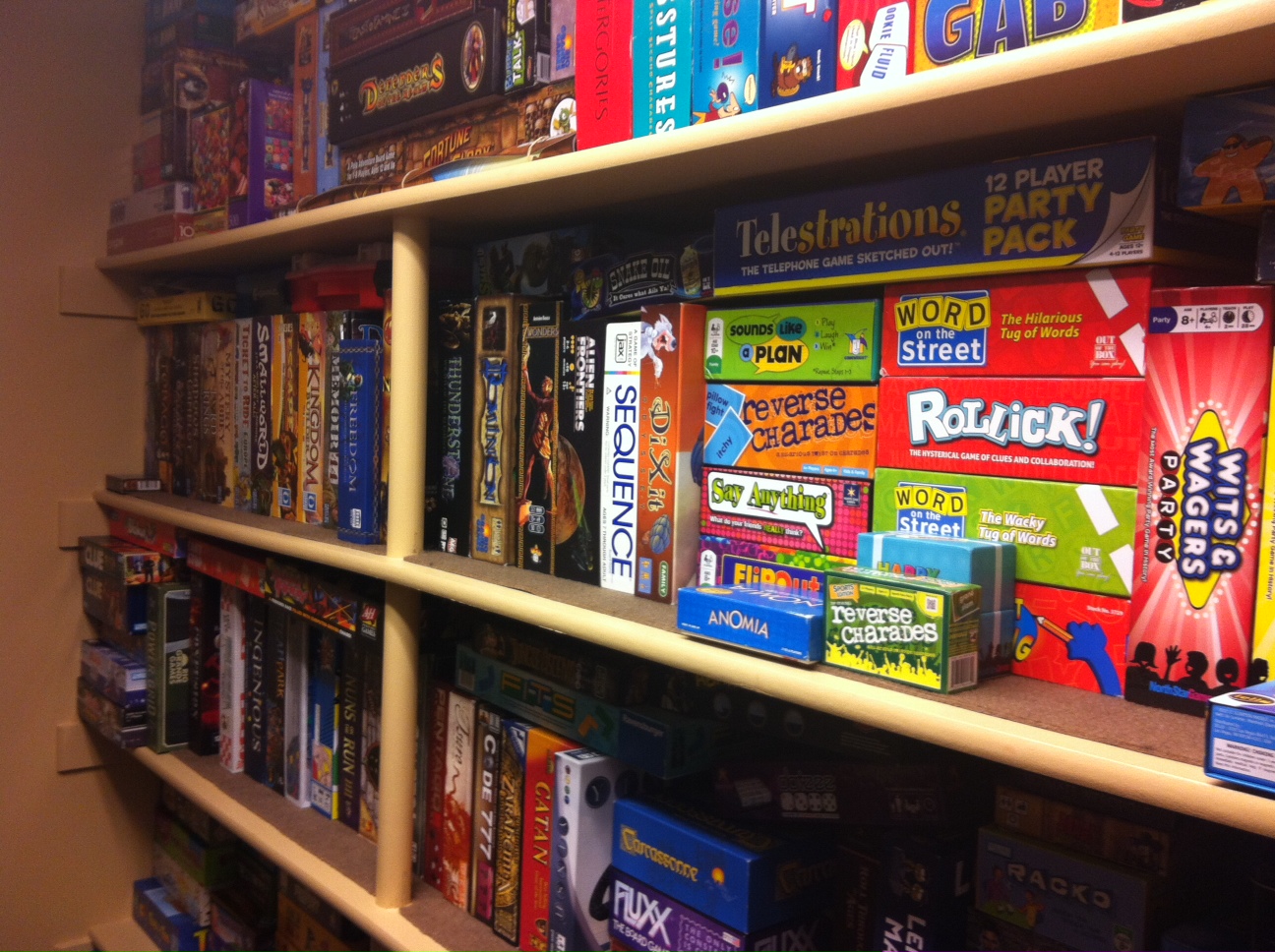

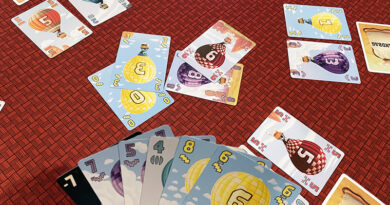
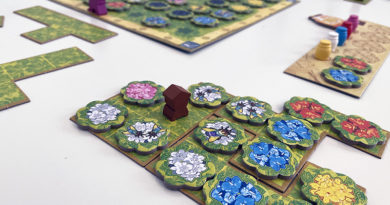
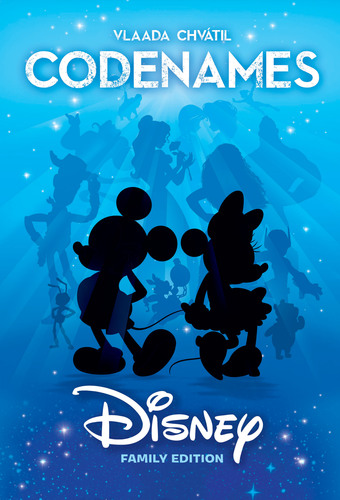
Question for ya.
I just backed this game on the 2nd Kick Starter and went all in. Given the thousands of cards I know no one would post pics of each. So here is my question. I know in recent years it seems like the fantasy artwork has been going down hill with the lady characters looking like they got borrowed from a pinup poster or adult novelty section as apposed to fighting monsters in a game. How is the female art? Being a father of 5 I’m quite picky when it comes to buying games to play solo or even with my kids. One deck dungeon was a huge hit due to the modesty of the female art.
Clint – I completely agree with you about typical female fantasy artwork. And it’s not just fantasy artwork where it appears in games. We added our own marker art to some of the card are in Love Letter: Batman for this same reason. I’ve passed on buying a number of games because of how they’ve portrayed female characters in their games. While we haven’t encountered every card in Thunderstone Quest yet, I haven’t yet come across any to eliminate. Although there are so many cards that if we do encounter a set with art we don’t like, we’ll gladly toss them in the trash and they won’t be missed.